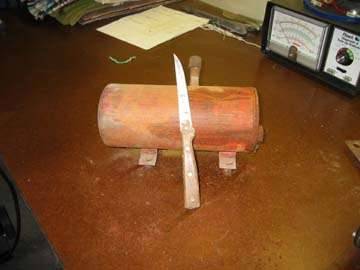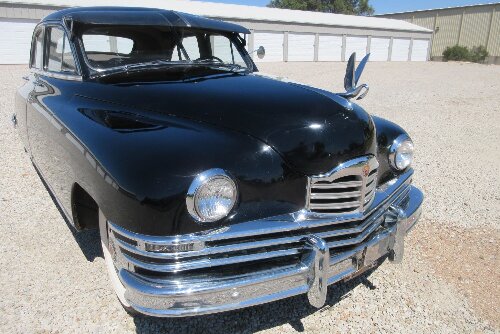|
Re: 1941 power windows
|
||||
|---|---|---|---|---|
|
Forum Ambassador
|
120-130 psi and in reverse, a vacuum of 15-18 inches per service counselor Vol 14 #19https://www.packardinfo.com/xoops/html/downloads/SC/SL-VOL14NO19.pdf There is an introductory description and some basic specs and testing info in that article as well.
Posted on: 2011/1/24 18:24
|
|||
|
Howard
|
||||
|
||||
|
Re: 1941 power windows
|
||||
|---|---|---|---|---|
|
Not too shy to talk

|
Thanks for the quick reply. I guess you need that much pressure because of the high ratio-window regulator design.
I needed a small shim under the relief valve spring to get pressure up to spec. When I checked vacuum, it pulled HARD, almost 30" ! (I expected my vac gauge to implode.) That's a dang powerful motor- those windows should go down just fine. 
Posted on: 2011/1/25 15:31
|
|||
|
||||
|
Re: 1941 power windows
|
||||
|---|---|---|---|---|
|
Forum Ambassador
|
The big spring pulling them down doesn't hurt either. Stretching that thing is probably why they need so much pressure.
Posted on: 2011/1/25 15:57
|
|||
|
Howard
|
||||
|
||||
|
Re: 1941 power windows
|
||||
|---|---|---|---|---|
|
Forum Ambassador
|
G'day ineffabill,
Just want to say,  to PackardInfo. to PackardInfo.
Posted on: 2011/1/25 19:05
|
|||
|
Mal
/o[]o\ ====  Bowral, Southern Highlands of NSW, Australia "Out of chaos comes order" - Nietzsche. 1938 Eight Touring Sedan - SOLD 1941 One-Twenty Club Coupe - SOLD 1948 Super Eight Limo, chassis RHD - SOLD 1950 Eight Touring Sedan - SOLD What's this?  Put your Packard in the Packard Vehicle Registry! Here's how! Any questions - PM or email me at ozstatman@gmail.com |
||||
|
||||
|
Re: 1941 power windows
|
||||
|---|---|---|---|---|
|
Home away from home
|
Using this same topic for further questions:
In service counselor Vol 14 #19, which HH56 posted, it shows a pump with apparently no reservoir and then an oil (brake fluid?) deposit. Many cars of the 40's with hydraulic systems have a pump and reservoir in one unit. Is this pump and reservoir on the '41's common with any other car? (You can tell that I am missing mine). Thanks, victor
Posted on: 2011/1/27 18:37
|
|||
|
||||
|
Re: 1941 power windows
|
||||
|---|---|---|---|---|
|
Forum Ambassador
|
All Packard hydraulic windows used brake fluid. Pre war pumps are unique and apparently good ones are somewhat hard to come by. They have a separate reservoir container and mount horizontally under the floor. Pump is reversible & turns one way for pressure up to raise and reverse direction for a suction effect helped by the spring to lower. Solenoid valve is inline with the hose to cylinder.
Postwar pumps are vertical and firewall or fender mounted, have an integral reservoir, and only turn one direction for pressure out to raise. Down relies on pump remaining off, just opening the solenoid valve built into the cylinder and spring pressure then pulling the window down.
Posted on: 2011/1/27 18:44
|
|||
|
Howard
|
||||
|
||||
|
Re: 1941 power windows
|
||||
|---|---|---|---|---|
|
Home away from home
|
Interesting explanation Howard. Thanks!
I will have to keep my eyes open for a prewar pump. Victor
Posted on: 2011/1/27 18:51
|
|||
|
||||
|
Re: 1941 power windows
|
||||
|---|---|---|---|---|
|
Home away from home
|
The '41 had a separate reservoir (for brake fluid) mounted to the frame next to the pump. Here's mine... please excuse my favorite scraping implement.
Attach file:  (11.74 KB) (11.74 KB)
Posted on: 2011/1/27 18:52
|
|||
|
||||
|
Re: 1941 power windows
|
||||
|---|---|---|---|---|
|
Webmaster
|
"The reason no one messes with JD's reservoir tank."
hahah
Posted on: 2011/1/27 19:02
|
|||
|
-BigKev
1954 Packard Clipper Deluxe Touring Sedan -> Registry | Project Blog 1937 Packard 115-C Convertible Coupe -> Registry | Project Blog |
||||
|
||||








